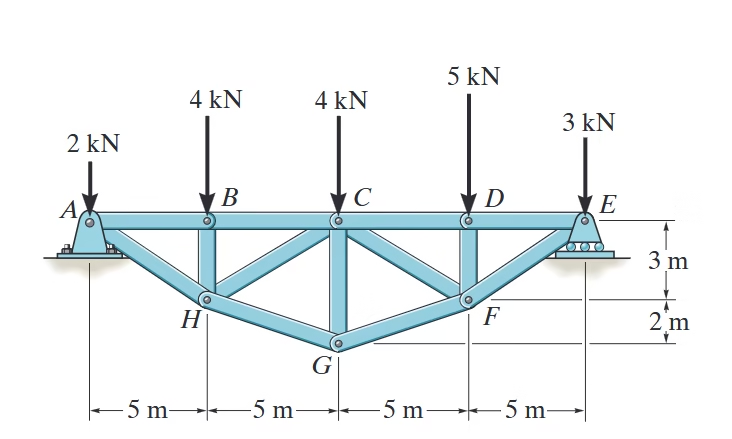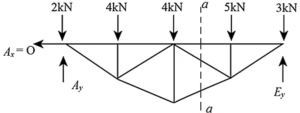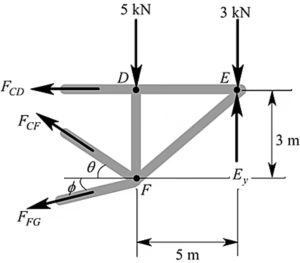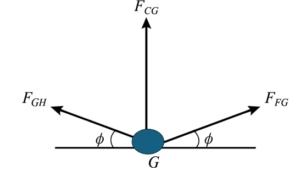$*6–40.$ Determine the force in members $CD$, $CF$, and $CG$ and state if these members are in tension or compression.

$ \text{Step by Step Solution} $
$ \text{Step 1: Given Data} $
We are tasked with determining the forces in members $CD$, $CF$, and $CG$ of the truss and identifying whether these forces are in tension or compression.
\begin{array}{c}
\text{Forces:} \\
P_1 = 2\,{\rm{kN}} \\
P_2 = 4\,{\rm{kN}} \\
P_3 = 4\,{\rm{kN}} \\
P_4 = 5\,{\rm{kN}} \\
P_5 = 3\,{\rm{kN}} \\
\text{Horizontal distances:} \\
AB = 5\,{\rm{m}} \\
BC = 5\,{\rm{m}} \\
CD = 5\,{\rm{m}} \\
DE = 5\,{\rm{m}} \\
\text{Vertical distances:} \\
EF = 3\,{\rm{m}} \\
FG = 2\,{\rm{m}}
\end{array}
$ \text{Step 2: Free Body Diagram} $
First, draw the free-body diagram of the truss system to visualize all applied forces and reactions.
$ \text{Step 3: Horizontal Reaction at A} $
The horizontal reaction $A_x$ is found by equilibrium of forces along the $x$-axis:
\begin{array}{c}
A_x = 0
\end{array}
$ \text{Step 4: Vertical Reaction at A} $
Taking moments about point $E$:
\begin{array}{c}
P_4(AB) + P_3(CD + DE) + P_2(BC + CD + DE) \\
+ P_1(AB + BC + CD + DE) – A_y(AB + BC + CD + DE) = 0 \\
5(5) + 4(10) + 4(15) + 2(20) – A_y(20) = 0 \\
165 = 20A_y \\
\hline
A_y = 8.25\,{\rm{kN}}
\end{array}
$ \text{Step 5: Vertical Reaction at E} $
Summing forces in the $y$-direction:
\begin{array}{c}
A_y + E_y – P_1 – P_2 – P_3 – P_4 – P_5 = 0 \\
8.25 + E_y – 2 – 4 – 4 – 5 – 3 = 0 \\
E_y = 9.75\,{\rm{kN}}
\end{array}
$ \text{Step 6: Free Body Diagram for Section a-a} $
Analyze the sectioned truss to isolate members $CD$, $CF$, and $CG$.
$ \text{Step 7: Length of Member CF} $
Using the Pythagorean theorem:
\begin{array}{c}
CF = \sqrt{(3\,{\rm{m}})^2 + (5\,{\rm{m}})^2} = \sqrt{34}\,{\rm{m}}
\end{array}
$ \text{Step 8: Length of Member FG} $
\begin{array}{c}
FG_{\text{length}} = \sqrt{(2\,{\rm{m}})^2 + (5\,{\rm{m}})^2} = \sqrt{29}\,{\rm{m}}
\end{array}
$ \text{Step 9: Force in Member CD} $
Taking moments about point $F$:
\begin{array}{c}
F_{CD}(3) – 3(5) + 9.75(5) = 0 \\
3F_{CD} + 33.75 = 0 \\
F_{CD} = -11.25\,{\rm{kN}} = 11.25\,{\rm{kN}}\,(\rm{C})
\end{array}
$ \text{Step 10: Force in Member CF} $
Summing forces in the $x$-direction:
\begin{array}{c}
-(-11.25) – F_{CF}\left(\frac{5}{\sqrt{34}}\right) – F_{FG}\left(\frac{5}{\sqrt{29}}\right) = 0 \\
F_{CF} = 13.12 – 1.08F_{FG}
\end{array}
$ \text{Step 11: Force in Member FG} $
Summing forces in the $y$-direction:
\begin{array}{c}
-5 – 3 + 9.75 + (13.12 – 1.08F_{FG})\left(\frac{3}{\sqrt{34}}\right) – F_{FG}\left(\frac{2}{\sqrt{29}}\right) = 0 \\
F_{FG} = 9.14\,{\rm{kN}}\,(\rm{T})
\end{array}
$ \text{Step 12: Solve for F_{CF}} $
Substituting back:
\begin{array}{c}
F_{CF} = 13.12 – 1.08(9.14) = 3.25\,{\rm{kN}}\,(\rm{T})
\end{array}
$ \text{Step 13: Free Body Diagram at Point G} $
Analyze forces acting at joint $G$.
$ \text{Step 14: Force in Member GH} $
Summing forces in the $x$-direction:
\begin{array}{c}
– F_{GH}\left(\frac{5}{\sqrt{29}}\right) + 9.14\left(\frac{5}{\sqrt{29}}\right) = 0 \\
F_{GH} = 9.14\,{\rm{kN}}
\end{array}
$ \text{Step 15: Force in Member CG} $
Summing forces in the $y$-direction:
\begin{array}{c}
9.14\left(\frac{2}{\sqrt{29}}\right) + 9.14\left(\frac{2}{\sqrt{29}}\right) + F_{CG} = 0 \\
F_{CG} = -6.8\,{\rm{kN}} = 6.8\,{\rm{kN}}\,(\rm{C})
\end{array}
$ \text{Conclusion} $
The force in member $CD$ is $11.25\,{\rm{kN}}$ in compression \\
The force in member $CF$ is $3.25\,{\rm{kN}}$ in tension \\
The force in member $CG$ is $6.8\,{\rm{kN}}$ in compression

Leave a reply